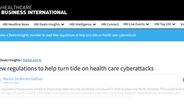- Lloyd Price
Patient Portals 3.0: the future of patient engagement

What exactly is patient engagement?
Patient engagement refers to the active involvement of patients in their own healthcare. It involves a partnership between patients and healthcare providers, with patients taking an active role in decisions about their care and treatment. Patient engagement can take many different forms, including:
Education: Providing patients with information about their health condition, treatment options, and self-management strategies can help to empower them to take an active role in their own care.
Communication: Encouraging open communication between patients and healthcare providers can help to build trust and improve the quality of care. This can involve listening to patient concerns, answering questions, and providing feedback.
Shared decision-making: Working with patients to make decisions about their own care, based on their individual preferences and values, can help to improve patient satisfaction and adherence to treatment plans.
Self-management: Providing patients with the tools and resources they need to manage their own health, such as mobile apps or patient portals, can help to improve patient outcomes and reduce the burden on the healthcare system.
Patient-centered care: Focusing on the needs and preferences of the patient, rather than the needs of the healthcare system, can help to improve patient satisfaction and outcomes.
Overall, patient engagement is a key component of high-quality healthcare. It involves empowering patients to take an active role in their own care, and working collaboratively with healthcare providers to make decisions about treatment and management of health conditions.
What is the future of patient portals?
The future of patient portals is likely to involve increased integration with other healthcare technologies, more personalized features, and greater emphasis on patient engagement and communication.
One trend that is likely to continue is the integration of patient portals with electronic health record (EHR) systems. This will allow patients to access their medical records, test results, and other health information more easily, and enable healthcare providers to share information more effectively.
In addition, patient portals are likely to become more personalized and tailored to individual patients' needs. For example, patients may be able to access customized care plans and educational materials based on their health conditions or personal preferences. They may also be able to communicate with their healthcare providers more easily through secure messaging and telemedicine features.
Another trend in patient portals is the use of artificial intelligence (AI) and machine learning (ML) to improve patient care. These technologies can help providers identify patterns in patient data, predict health outcomes, and provide more personalized treatment recommendations.
Finally, patient portals are likely to continue to evolve in response to changing patient needs and preferences. For example, younger patients may prefer mobile apps that allow them to access their health information and communicate with their providers on-the-go, while older patients may prefer more traditional web-based portals.
Overall, the future of patient portals is likely to involve a greater emphasis on patient engagement, more seamless integration with other healthcare technologies, and continued innovation in response to evolving patient needs and preferences.

What are the advantages of hospital patient portals?
Hospital patient portals have several advantages, both for patients and healthcare providers. Here are some of the key benefits:
Improved patient engagement: Patient portals allow patients to access their health information, test results, and medical history from anywhere with an internet connection. This can help patients take a more active role in their own healthcare and improve their overall health outcomes.
Increased efficiency: Patient portals can streamline administrative tasks, such as scheduling appointments, refilling prescriptions, and filling out forms. This can save time for both patients and healthcare providers, and reduce the risk of errors or delays.
Enhanced communication: Patient portals can provide a secure platform for patients to communicate with their healthcare providers. Patients can ask questions, request appointments, and receive updates on their care without having to make phone calls or visit the hospital in person.
Better patient outcomes: Studies have shown that patients who use patient portals are more likely to adhere to their treatment plans, have better chronic disease management, and experience improved health outcomes overall.
Reduced healthcare costs: Patient portals can reduce healthcare costs by minimizing the need for in-person visits and administrative tasks. This can also improve access to care for patients who may have difficulty traveling to the hospital or taking time off work.
Overall, hospital patient portals can improve patient engagement, increase efficiency, enhance communication, improve patient outcomes, and reduce healthcare costs.
What are the disadvantages of hospital patient portals?
While hospital patient portals offer many advantages, there are also some potential disadvantages to consider. Here are a few examples:
Limited access: Some patients may not have access to the internet or may not be comfortable using digital technologies, which could limit their ability to use patient portals effectively.
Security concerns: Patient portals contain sensitive health information, which could be vulnerable to data breaches or unauthorized access. It's important for hospitals to implement strong security measures to protect patient information.
User experience: Patients may find some patient portals difficult to use or navigate, which could discourage them from using the portal or lead to frustration.
Incomplete information: While patient portals can provide patients with access to their health information, there may be gaps in the information available or errors in the data. Patients may need to rely on their healthcare providers to fill in these gaps or correct errors.
Dependence on technology: Patient portals rely on technology, which can sometimes fail or be unavailable. This could limit patients' ability to access their health information or communicate with their healthcare providers.
It's important to note that many of these disadvantages can be mitigated through proper training, education, and implementation of patient portals. Hospitals can also work to address these concerns by listening to patient feedback and continuously improving their patient portal systems.

What are the clinical benefits of patient engagement?
Patient engagement can have several clinical benefits, both for individual patients and the healthcare system as a whole. Here are some examples:
Improved health outcomes: When patients are engaged in their own care, they are more likely to adhere to treatment plans, take medications as prescribed, and make positive lifestyle changes. This can lead to improved health outcomes, such as better management of chronic conditions and reduced risk of complications.
Increased patient satisfaction: When patients feel more involved in their own care, they are more likely to be satisfied with their healthcare experience. This can improve patient loyalty and retention, and lead to better patient-provider relationships.
Better communication: Patient engagement can improve communication between patients and healthcare providers, making it easier to share information and make decisions about treatment. This can lead to more effective care and better health outcomes.
Increased patient safety: Patient engagement can help to identify potential safety issues or errors before they become serious problems. Patients who are engaged in their own care are more likely to notice changes in their symptoms or medication side effects, and to report them to their healthcare providers.
More efficient use of healthcare resources: When patients are engaged in their own care, they are less likely to require emergency room visits or hospitalizations. This can reduce the strain on the healthcare system and lead to cost savings for both patients and providers.
Overall, patient engagement can lead to improved health outcomes, increased patient satisfaction, better communication, increased patient safety, and more efficient use of healthcare resources.
What is the future of patient engagement?
The future of patient engagement is likely to involve a greater emphasis on digital technologies, personalized care, and proactive communication. Here are some of the key trends to watch for:
Digital engagement: As patients become more comfortable with digital technologies, healthcare providers are likely to continue to invest in digital engagement tools, such as patient portals, telemedicine, and mobile health apps. These technologies can make it easier for patients to access health information, communicate with their healthcare providers, and manage their own health.
Personalized care: Patients are increasingly looking for personalized care that takes into account their individual needs, preferences, and health goals. Healthcare providers are likely to respond by developing more customized care plans and treatment recommendations, leveraging technologies such as machine learning and artificial intelligence to analyze patient data and provide more personalized care.
Proactive communication: Rather than waiting for patients to reach out when they have a problem or need assistance, healthcare providers are likely to become more proactive in their communication with patients. This could involve regular check-ins, automated reminders, and other forms of outreach designed to keep patients engaged and informed.
Community engagement: Patients are more likely to stay engaged in their healthcare when they feel connected to a community of other patients who are going through similar experiences. Healthcare providers are likely to invest in tools and programs that foster patient communities and support patient engagement.
Focus on wellness: As the healthcare industry continues to shift towards a more holistic view of health, patient engagement is likely to focus more on wellness and prevention, rather than just treating illness. Healthcare providers may offer more education and resources to help patients maintain a healthy lifestyle and prevent chronic conditions.
Overall, the future of patient engagement is likely to involve a greater focus on digital tools, personalized care, proactive communication, community engagement, and wellness.
Thoughts, comments? Tweet @lloydgprice, or email lloyd@healthcare.digital and let's start a conversation :)







